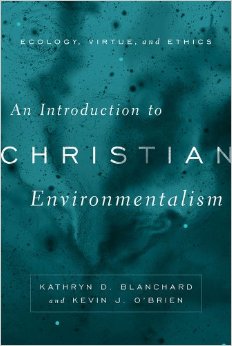Kathryn D. Blanchard and Kevin J. O’Brien
Waco, Baylor University Press, 2014. 220 pp. $35.96.
Both Kathryn Blanchard and Kevin O’Brien are Associate Professors of Religion at Christian liberal arts colleges, and their familiarity with this student demographic as well as their passion for teaching shape their approach throughout this book. Ecology, Virtue, and Ethics aims to critique the knee-jerk anti-environmental stance of students who come from fundamentalist or evangelical backgrounds and in its place offer a virtuous way of engaging in dialogue about complex environmental problems. While this book makes for a good introduction to an array of environmental issues, the authors’ refusal to advance a coherent argument about any of the seemingly intractable problems they raise becomes rather frustrating to readers actually looking to cultivate environmental virtues.
Perhaps the clearest way that I can characterize their approach is by situating it within the three-part categorization I applied to my professors when I was a student. There were the Activist professors who sought to indoctrinate their students, the Tolerant or Open-Minded professors who laid out a range of perspectives but never let their students know what they thought, and the Wise professors who provided students with the varied voices in a conversation and then explained what they thought and why. As my labels indicate, I preferred the latter approach because it modeled for me a way of open dialogue that leads to a clear position. The approach that Blanchard and O’Brien take, however, is the Tolerant one; they would likely disagree with Chesterton’s adage that “the object of opening the mind, as of opening the mouth, is to shut it again on something solid.”
Applying Virtue Ethics to Environmental Quandaries
To be fair, though, Blanchard and O’Brien argue that such an open-minded stance is necessitated by the complexity of the environmental problems we face. As the authors point out, each time we purchase a banana at the grocery store we participate in a long chain of environmental actions: habitat destruction, pesticide use, unjust labor conditions, and fossil fuel use for transportation. We now have much information about these problems, but the sheer amount of information and the scale of our environmental challenges can be overwhelming and paralyzing. The authors wisely turn to virtue ethics as a way to navigate this information overload; instead of searching for some simplistic list of rules, virtue ethics emphasizes character, a right way of being human. As they put it, “Christian virtue ethics is well suited to moral complexity, because it focuses not on universal rules to be obeyed or applied to specific choices but on habits of human character nurtured over time through daily practice and multiple interactions” (11). After laying out their case for a virtue-ethics approach, the remainder of the book consists of chapters that pair one virtue—each of the four cardinal virtues and the three theological virtues—with one environmental problem.
Following this paired approach enables the authors to discus each virtue and then examine how different people try to embody this virtue in the context of a particular environmental issue. So the chapter on prudence contrasts altruistic species conservation with Free Market Environmentalists who look for ways to incentivize the preservation of endangered ecosystems. The chapter on courage focuses on energy, considering those who argue in favor of cleaner fossil fuels, like natural gas, those who argue for a faster shift to alternative energies, and those who argue for drastically reduced consumption. The chapter on temperance examines food, seeking a balance between industrial and small-scale farming as well as a balance between private eating practices and public forms of responsible eating. The chapter on justice compares those who seek environmental justice through political revolution with those who desire to reform the current systems. The chapter on faith looks at various responses to climate change, including people who make small-scale, personal changes, those who seek big political changes, and those who look for technological solutions. The chapter on hope considers different political and personal approaches to the rapidly growing human population. Finally, the chapter on love presents six examples of people who have worked out their love for the environment in a wide variety of ways.
While this organization has merit in principle, in practice some of the connections between the virtue at hand and the particular environmental issue appear forced. For instance, the temperance chapter begins by defining temperance as proper enjoyment, as finding the right balance between excessive and insufficient desire for, in this case, food (64-65). However, after this introductory definition, the remainder of the chapter shifts to consider the proper “balance” between different types of food production and consumption. We hear from those who support industrial agriculture and those, like Michael Pollan, who advocate for less chemical-intensive, fossil-fuel dependent modes of farming. The authors then conclude, “Christians are called to listen carefully to all accounts and temperately examine each claim while not shirking our duty of loving God and neighbor” (74). Temperance has apparently become a virtue that entails even-handed listening. Blanchard and O’Brien use a similar definition of temperance when contrasting those who see responsible eating as a private act and those who emphasize its public dimensions. They conclude: “On one hand, temperance calls Christians to note that, as individual adults, we must take responsibility for ourselves. On the other hand, it also requires us to consider our own eating in a broader social and cultural context that none of us alone creates” (75). And two pages later “temperance demands thinking together as communities to discern the interconnections and interdependencies that inform every dietary choice each of us makes” (77). Later still, temperance is redefined again: “temperance means taking responsibility for our choices and their short- and long-term impacts” (81). I suppose it’s possible that temperance entails a consideration of the cultural contexts of our eating and its impacts, but this seems rather distant from the initial definition of temperance as a proper balance between excessive and insufficient desire for food. The authors provide little aid in connecting these various uses of temperance, and by the end of the chapter, when they are discussing the pros and cons of golden rice, the virtue of prudence seems much more pertinent than temperance.
Clinging to the Golden Mean
Part of the reason temperance and the other virtues become so chameleon-like is that Blanchard and O’Brien seem to use the notion of “balance” or the “golden mean” in differing ways. At times, they use it in the traditional, Aristotelian sense to describe the way that virtues chart a middle ground between opposing vices: courage, for instance, is the mean between “cowardice and recklessness” (43). But they also use the “golden mean” to refer to the way “eco-virtue” strives for a middle ground between differing approaches to environmental problems (22). This equivocation has the effect of making all the virtues sound like various ways of compromising between or “engaging” (an oft-used word in this book) with conflicting positions.
It is their adherence to this latter sense of the golden mean that made this book—despite the promise of its approach—ultimately unsatisfying to me. Near the end of their introductory chapter on eco-virtue, Blanchard and O’Brien note the dangers of never taking a clear, actionable position:
Clinging too rigidly to the middle course—becoming fundamentalists about the golden mean—poses the risk of too much compromise and complacency, the paralysis that comes from constant second-guessing or the muddle that comes from trying to please everyone. . . . Christian environmentalists must be committed not only to listening and conversing broadly but also to doing something from those conversations, responding virtuously to the problems we face. (22)
Throughout the following discussions of various environmental challenges, however, the authors never emerge from the muddle of trying to find positive aspects in every side of the debate.
When discussing different responses to the growth of the human population—contrasting those who think the earth can support more humans with those who think Christians should have fewer children—Blanchard and O’Brien simply conclude that whatever choice we make should be based on hope rather than fear. While this is fine advice, it sidesteps the difficult question of what hope actually means in this context. Each chapter similarly refuses to adjudicate between conflicting understandings of the virtue at hand. In the chapter on love, for instance, they list six different figures who work out their affection for creation in widely differing ways, some through radically simple lives and others—like Dave Foreman or Ed Abbey—through sabotaging development. The authors recognize that these different actions come from different understandings of what love entails, and so they conclude that people “who love creation, creatures, and their creator will have to choose among these tactics and must be prepared to defend their choices” (161). Yet Blanchard and O’Brien never advocate for one of these six approaches over the others; by not choosing, they never have to defend their choices or their understanding of a particular virtue. Such engagement without discernment is insufficient, however, because as time-bound humans we make irreversible acts each moment, and virtues that do not shape these actions are not virtues at all.
Learning to Practice Virtue
The rather tepid aims of this book become apparent in the conclusion when Blanchard and O’Brien recapitulate the virtues they have covered. Instead of hoping that their book has challenged readers to become more virtuous humans, they seem content with simply raising awareness. The following list of clauses is taken from their summary of the way that each chapter should have changed its readers: “you are aware … you can access sufficient courage to think carefully … you can reflect carefully … you can consider … you realize … you are prepared to think … you are aware … you can contemplate the impact … you might wonder” (167). It seems, then, that each of the seven virtues has been reduced to having an open mind about a variety of approaches to environmental challenges. While this is certainly a good place to start, it is an insufficient place to conclude. At the end of this book, I was still waiting for Blanchard and O’Brien to model the discernment that characterizes wise, virtuous action in the face of complex environmental difficulties.
Perhaps the reason this review is more negative than I would like it to be is that I had such high hopes for this book. Virtue ethics has the resources to enrich Christian environmentalism and enable Christians to think and act in ways that rightly value creation. And Ecology, Virtue, and Ethics does have merits. It maintains a remarkably unified voice even though it is written by two authors who teach at institutions across the country from one another, and it serves as a “beginner’s tool kit” that introduces environmental issues to students at Christian colleges (169). This book could work well in a course on Christian environmentalism, particularly if the professor made up for the text’s inadequacies by leading students through the process of weighing the conflicting understandings of each virtue. Even in such a context, however, I worry that this book will end up frustrating thoughtful students who want more rigorous discussion and a coherent stance.





